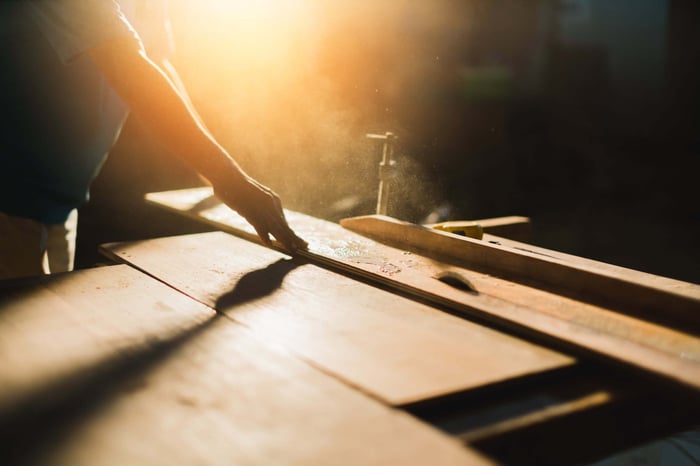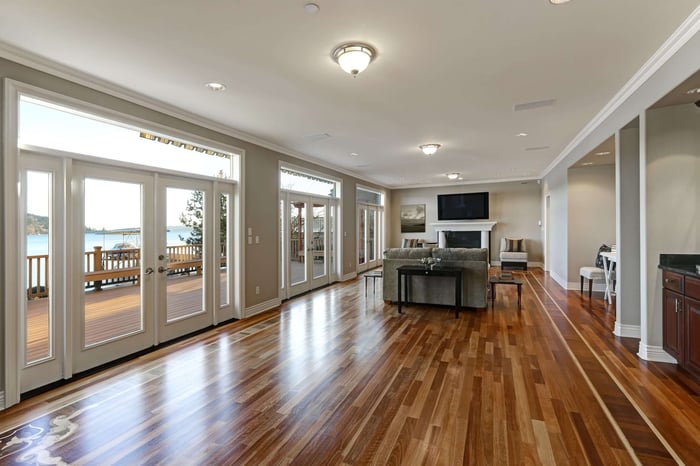When choosing hardwood flooring, the type of wood you select significantly impacts your space's final look, feel, and longevity. Some species and variations of hardwood offer lighter looks ideal for bright workshops or kitchens, while other kinds of hardwood provide a rich, dark atmosphere well-suited for dens and communal spaces.
Oak has a long-standing reputation as a durable, beautiful choice for hardwood flooring. Residential and commercial property owners choose this type of hardwood for its color variations, hard grain, and proven ability to withstand wear and tear. However, even when property owners have narrowed their flooring selection down to oak, more decisions remain.
Fortunately, choosing the ideal type of oak flooring for your home doesn’t have to be a challenge. At Harper Floors, our mission involves providing in-depth product knowledge and helping customers choose the right flooring faster.
In this blog, we talk about ways buyers can discern between European vs. American oak flooring and choose the species that is right for them. For specific information about European oak flooring from Harper Floors, visit our product pages or call our customer service team at 888-807-2704 with your questions today.
How to Distinguish Between European and American Oak
Knowing the difference between European and American oak species helps ensure the flooring material you’re paying for is the quality you expect. Read up on the methods below to spot the differences in European vs. American oak flooring.
Method One: Species and Origin
With labeled hardwood flooring, buyers can quickly discern between American, European, and English oak species. Check your sample’s product label or reach out to your retailer to find out the hardwood’s origin.
American hardwood may be sourced from the southern and Pacific Northwest regions of North America. European hardwood may come from Ireland, France, Germany, Ukraine, and other European countries.
American and European oak bear many similarities as temperate hardwoods and separate white oak species, though each has its unique drawing points. However, European hardwood has increased in popularity over the years over American hardwood and often stands out as the superior species of choice.
Dealing with unlabeled hardwood or oak of unknown origin? We’ve got you covered. Keep reading to find out trained ways to tell European and American oak apart.
Method Two: Grain Pattern
American oak flooring displays clean, uniform grain patterns with subtle highlighting and lowlighting.
European oak flooring, in contrast, offers distinctive variation in grain pattern with bolder swirls and pronounced ribbon-like markings, known as medullary rays. These wavy and somewhat knotted grain patterns provide a more natural look relative to other species of wood.
Method Three: Color
Both American and European oak classify as white oak, although a red variant of American oak does exist.
Both American and European oak present a generally lighter color, however, European oak embodies a rich golden hue that sets it apart from the slightly dull American oak natural color.
Method Four: Tone Variation
When comparing European vs. American oak flooring, European oak offers more consistent tones and shades. This consistency makes furnishing large indoor spaces with a uniform aesthetic less challenging.
American oak, by contrast, showcases more extreme differences between light and dark tones. This varied color palette suits bold interior decorating styles and can become its own unique statement piece in a space.
Method Five: Board Strength
European oak showcases a proven, durable core that stands up to more wear and tear than other species of oak. This added strength increases the flexibility of the boards, making them ideal for high-traffic commercial spaces or busy homes.
Though a durable hardwood in its own right, American oak doesn’t provide the same resilience as its European counterpart which has an incredible janka hardness rating. This tests the hardness of wood, and its durability, which cannot be determined in store and can only be provided by the manufacturer.
Method Six: Fuming
Fuming, a chemical process that darkens the wood, draws out the rich, deeper tones in natural hardwood like American and European oak.
However, natural variations in color, tone, and grain pattern give the fuming process different results in different types of hardwood. While fuming brings out dependable, rich tones in European oak, the process produces inconsistent results with American oak. Keep this in mind when selecting fumed hardwood to use for your indoor spaces.
Method Seven: Finishing Options
Finishing options vary for European vs. American oak flooring. Due to the wood's natural warmth and responsive nature, European oak lends itself to more staining and finishing possibilities. Some types of French oak, for example, carry a natural oil finish that brings out the golden tones while protecting the natural look of the wood.
In contrast, American oak often comes prefinished with a polyurethane finish. While this finish provides a sleek, bright look, it offers few customization options and may look unnatural.
The Importance of Choosing the Right Wood Flooring
Hardwood flooring represents a significant investment in your residential or commercial space. When choosing material for a new or updated hardwood floor, take the opportunity to make the most of that investment. Choose a long-lasting, durable hardwood that provides flexibility, strength, and customization.
The Harper Floors Difference
At Harper Floors, we strive to make purchasing hardwood flooring material easier than ever. On our website, you’ll find all the information you need to make an informed decision about your hardwood floor investment, as well as convenient shipping options, material samples, and more.
Find Expert Guidance for Wood Flooring Options
When it comes to European vs. American oak, European oak provides superior durability, depth of color, and a variety of finishing options. Now that you can tell the difference between these two hardwood staples, keep browsing our blog to learn more about engineered vs. solid hardwood floors, how to find a flooring installer, and more.
Ready to get started? Our Harper Floors team makes building or remodeling your hardwood floors a breeze. Use our online form to request a free quote or get your hands on some flooring samples by calling 888-807-2704 today.









